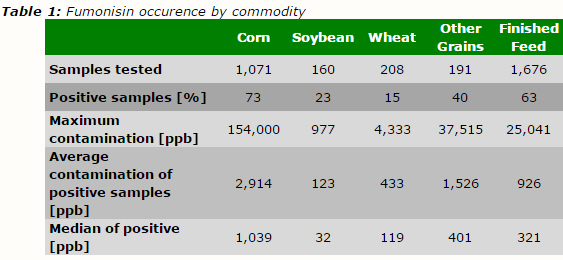



Fumonisins: an Underestimated Threat to Poultry
GLOBAL - Intensive scientific research over the last 15 years has revealed alarming ways that fumonisins interact with birds’ immune and digestive systems, says Biomin.
Fumonisin Prevalence
Globally, the predominant grain used in poultry feeds is corn (maize). As the occurrence of fumonisins is ubiquitous and not limited to a specific climate, these toxic substances constitute a worldwide phenomenon.
The latest Biomin Mycotoxin Survey results show that 73 per cent of 1,071 corn samples analysed tested positive for fumonisin contamination with an average of positives of 2,914 parts per billion, or ppb. Sixty-three per cent of 1,676 finished feed samples analysed tested positive for fumonisins with an average contamination of 926ppb.

Understanding Fumonisins' Effects in Poultry
Cutting-edge technologies allowing for more finely-tuned analysis of mycotoxins and their impacts on animals account for recent evidence that fumonisins occurring at subclinical concentrations predispose birds to metabolic and immunologic disorders.
Recent data showed that the ingestion of fumonisins affected the expression of proteins related to pro- and anti-inflammatory responses in the intestinal tract of broiler chickens (Grenier et al., 2014). At a concentration of 20ppm - the limit set by the EU for poultry - fumonisins induce higher excretion of Eimeria strains, parasites responsible for coccidiosis (Grenier et al., 2015). Considering the high density of birds in large-scale operations, the ingestion of contaminated feed with fumonisins may promote the parasite transmission between birds.
A separate experiment using similar concentrations reported an effect on proteins in chickens’ intestines involved in drug metabolism that could alter the effectiveness of some drugs (Antonissen et al., 2014). Altogether, these recent findings suggest that the intestinal tract of birds is very sensitive to the exposure to fumonisins.
Conclusion
For a long time poultry have been suggested to be less susceptible to fumonisins lacking clinical signs of impairment even with high contamination levels.
Recent findings focusing on subclinical effects of fumonisins suggest that the intestinal tract of birds is very sensitive to the exposure to fumonisins.
Results of scientific studies in different poultry species indicate that fumonisins indeed represent a major risk to animal health.











